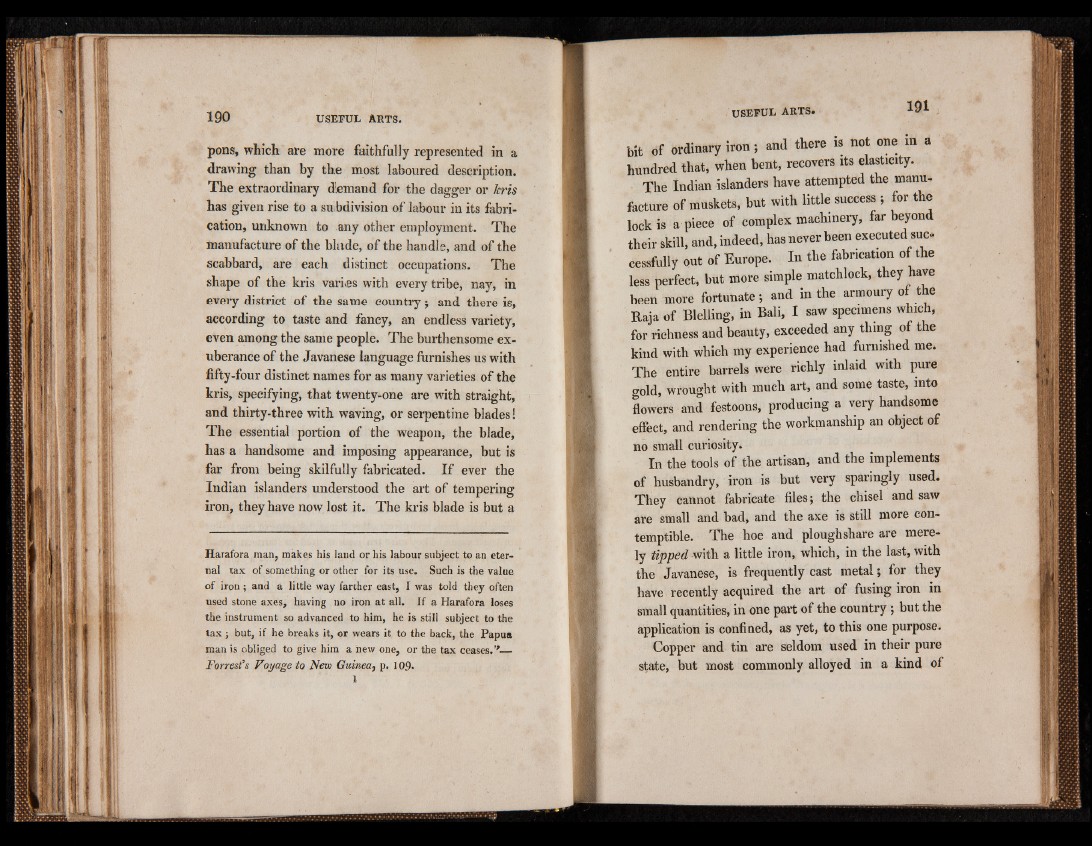
pons, which are more faithfully represented in a
drawing than by the most laboured description.
The extraordinary d;.emand for the dagger or kris
has given rise to a subdivision of labour in its fabrication,
unknown to any other employment. The
manufacture of the blade, of the handle, and of the
scabbard, are each distinct occupations. The
shape of the kris varies with every tribe, nay, in
every district of the same country; and there is,
according to taste and fancy, an endless variety,
even among the same people. The burthensome exuberance
of the Javanese language furnishes us with
fifty-four distinct names for as many varieties of the
kris, specifying, that twenty-one are with straight,
and thirty-three with waving, or serpentine blades!
The essential portion of the weapon, the blade,
has a handsome and imposing appearance, but is
far from being skilfully fabricated. If ever the
Indian islanders understood the art of tempering
iron, they have now lost it. The kris blade is but a
Harafora man, makes his land or his labour subject to an eternal
tax of something or other for its use. Such is the value
of iron; and a little way farther east, I was told they often
used stone axes, having uo iron at all. If a Harafora loses
the instrument so advanced to him, he is still subject to the
lax ; but, if he breaks it, or wears it to the back, the Papua
man is obliged to give him a new one, or the tax ceases.’*—
Forrest’s Voyage to New Guinea, p. 109.
bit of ordinary iron j and there is not one in a
hundred that, when bent, recovers its elasticity.
The Indian islanders have attempted the manufacture
of muskets, but with little success ; for the
lock is a piece of complex machinery, far beyond
their skill, and, indeed, has never been executed successfully
out of Europe. In the fabrication of the
less perfect, but more simple matchlock, they have
been more fortunate; and in the armoury of the
Raja of Blelling, in Bali, I saw specimens whic ,
for richness and beauty, exceeded any thing of the
kind with which my experience had furnished me.
The entire barrels were richly inlaid with pure
gold, wrought with much art, and some taste, into
flowers and festoons, producing a very handsome
effect, and rendering the workmanship an object of
no small curiosity.
In the tools of the artisan, and the implements
of husbandry, iron is but very sparingly used.
They cannot fabricate files; the chisel and saw
are small and bad, and the axe is still more contemptible.
The hoe and ploughshare are merely
tipped with a little iron, which, in the last, with
the Javanese, is frequently cast metal; for they
have recently acquired the art of fusing iron in
small quantities, in one part of the country; but the
application is confined, as yet, to this one purpose.
Copper and tin are seldom used in their pure
state, but most commonly alloyed in a kind of